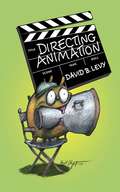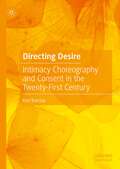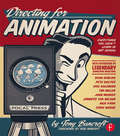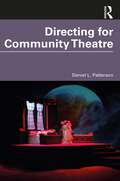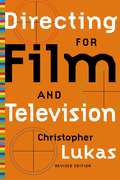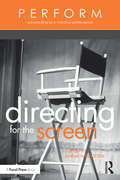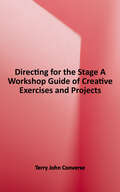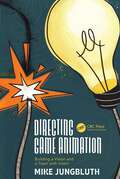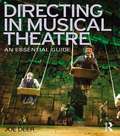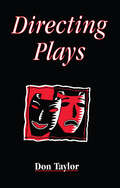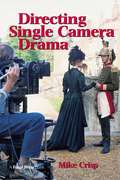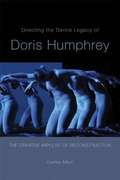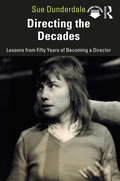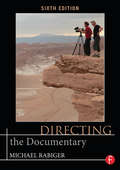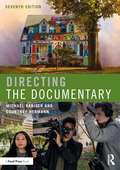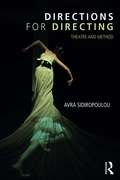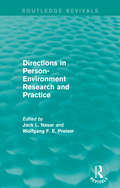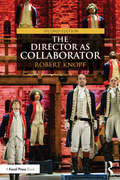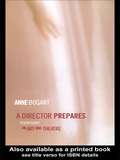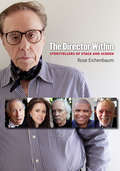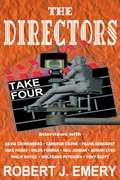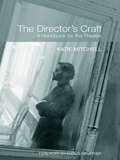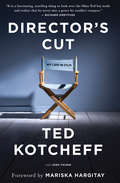- Table View
- List View
Directing Animation
by David B. LevyBoth experienced and aspiring animation professionals will find Directing Animation a comprehensive and entertaining guide to understanding the director's creative role in managing the entire animation process. An animation director doesn't simply direct animation. He or she directs people who animate and must be equally able to relate to the crew, producers, writers, creators, and clients. Readers will learn how to: -- direct commercials, TV series, feature films, and Web features and series -- land their first big directorial break -- create realistic schedules and pipelines -- assemble the best crew for any job -- motivate animators and crew members -- give constructive feedback and notes -- maintain good relationships with producers, creators, writers, and network executives. In addition to over eighty photographs and illustrations, Directing Animation includes insider tips and firsthand experience from animators, directors, and producers, revealing the best ways to manage the production process while creating a workplace that is both efficient and fun.
Directing Desire: Intimacy Choreography and Consent in the Twenty-First Century
by Kari BarclayDirecting Desire explores the rise of consent-based and trauma-informed approaches to staging sexually and sensually charged scenes for theater in the contemporary U.S., known as intimacy choreography. From 2015 to 2020, intimacy choreography transformed from a grassroots movement in experimental and regional theaters into a best practice accepted in Hollywood and on Broadway. Today, intimacy choreographers have become a veritable "intimacy industry" in the cultural sphere, sparking attention from Rolling Stone to The New York Times to the sketch comedy series Saturday Night Live. This book analyzes the forces that have led to intimacy choreography’s meteoric rise and asks what implications the field has for theater practice more broadly. Building a theoretical framework for intimacy directing, Directing Desire also strives to reorient the conversation in the field so that artists understand not only best practices in consent but also intersectional frameworks that expand and rework consent.
Directing for Animation: Everything You Didn't Learn in Art School
by Tony BancroftThere’s no class in art school that can teach you this. Believe it or not, there’s a lot more to directing a great animated film than beautiful illustrations and cool characters. You need to bring out your inner creative visionary and take your savvy leadership skills to the front lines - being great with a pencil, brush, or stylus is not enough. Tony Bancroft released his inner creative visionary when creating Mulan. In Directing for Animation he shows you exactly how. Pull the right strings to bring your characters to life and center your story by developing the visual cues that lend to your audiences understanding of the plot, place, and purpose. Tony walks you through the process, bringing you behind the scenes of real, well-known projects - with a little help from some famous friends. Learn from the directors of Aladdin, The Little Mermaid, Ice Age, Chicken Run, and Kung Fu Panda, and see how they developed stories and created characters that have endured for generations. Get the inside scoop behind these major features…pitfalls and all.
Directing for Community Theatre
by Daniel L. PattersonDirecting for Community Theatre is a primer for the amateur director working in community theatre. With an emphasis on preparedness, this book gives the amateur director the tools and techniques needed to effectively work on a community theatre production. Covering play analysis, blocking, staging, communication, and working with actors, designers, and other theatre personnel, this how-to book is designed to have the community theatre director up and running quickly, with full knowledge of how to direct a show. The book also contains sample forms and guidelines, including acting analysis, character analysis, rehearsal schedule, audition form, prop list, and blocking pans. Directing for Community Theatre is written for the community theatre participant who is interested, or already cast, in the role of the director.
Directing for Film and Television: Revised Edition
by Christopher LukasLegendary stories portray directors as eccentric, moody savants who possess a genius for the film medium that mere mortals could never grasp. Throughout cinematic history, gushing accounts have cast the likes of DeMille, Hitchcock, Fellini, and Spielberg as sorcerers, rather than tradesmen. Now confounding these lofty perceptions, acclaimed veteran director Christopher Lukas examines the craft and art of directing as a teachable, learnable profession.
Directing for the Screen (PERFORM)
by Anna WeinsteinDirecting for the Screen is a collection of essays and interviews exploring the business of directing. This highly accessible guide to working in film and television includes perspectives from industry insiders on topics such as breaking in; developing and nurturing business relationships; the director’s responsibilities on set and in the field; and more. Directing for the Screen is an ideal companion to filmmaking classes, demystifying the industry and the role of the director with real-world narratives and little-known truths about the business. With insight from working professionals, you’ll be armed with the information you need to pursue your career as a director. Contains essays by and interviews with television directors, feature directors, documentary filmmakers, commercial directors, producers, and professors. Offers expert opinions on how to get started, including landing and succeeding in an internship and getting your first gig. Reveals details about working with actors, overseeing the work of often hundreds of crewmembers, writing last-minute on set, and developing a working relationship with producers and screenwriters. Explores strategies for doing creative work under pressure, finding your directorial voice, financing shorts and independent films, breaking down barriers and overcoming discrimination, shooting in less-than-ideal situations, and recovering from bad reviews or box office results. Illuminates the business of directing in the United States (New York and Los Angeles) as compared to other countries around the globe, including England, Ireland, Spain, Australia, Denmark, Pakistan, Belgium, and Canada.
Directing for the Stage: A Workshop Guide for 42 Creative Training Exercises and Projects
by Terry John ConverseThe 42 exercises detailed in this comprehensive guide provide both the instructor and the student with a 'user-friendly' workshop structure. The basic concepts of directing are learned progressively. This approach is totally new -- the student discovers the demands and problems of directing by actually doing it step-by-step. The student's own directing style emerges with each exercise.
Directing Game Animation: Building a Vision and a Team with Intent
by Mike JungbluthThe best character animation has a strong creative intent, driving a compelling performance. With the addition of interactivity, game animation adds complexity to the craft of how best to balance art, design and technology to realize a character’s performance. As a director, you are responsible for not only defining a vision for how those should balance but also being a leader, mentor and advocate for your team. But in a field of rapid iteration of ideas and techniques, that strong creative intent can be easily lost or sacrificed if not properly fostered and defined.Directing Game Animation: Building a Vision and a Team with Intent breaks down the process of creating an intentional animation vision that can be both unique and flexible. From defining the high-level experience to breaking down tech needs, projecting a team size and empowering everyone to work together, this book will help you to wrap your mind around a project’s animation needs.Animation, like every part of a game, cannot succeed—let alone function—in a vacuum. This book looks to foster a discussion around the process, needs and benefits of an empowered animation team and its vision as a universal benefit for the entire industry.This book is a guide to answer some of the most common questions people encounter when engaging with the overlap between creative and project leadership. What is your role? Learn how to establish expectations and needs specific to the project and team. How do you establish a vision? Learn how to better define and communicate creative topics such as a cohesive character performance and animation style. How do you build a team? Learn how to establish early on the team structure, skills and workflows needed to deliver on the needs of the project. How do you balance creative and production needs? Learn how to define quality, reviews and approvals in a way that empowers creativity and decision-making.
Directing in Musical Theatre: An Essential Guide
by Joe DeerThis comprehensive guide, from the author of Acting in Musical Theatre, will equip aspiring directors with all of the skills that they will need in order to guide a production from beginning to end. From the very first conception and collaborations with crew and cast, through rehearsals and technical production all the way to the final performance, Joe Deer covers the full range. Deer’s accessible and compellingly practical approach uses proven, repeatable methods for addressing all aspects of a production. The focus at every stage is on working with others, using insights from experienced, successful directors to tackle common problems and devise solutions. Each section uses the same structure, to stimulate creative thinking: Timetables: detailed instructions on what to do and when, to provide a flexible organization template Prompts and Investigations: addressing conceptual questions about style, characterization and design Skills Workshops: Exercises and ‘how-to’ guides to essential skills Essential Forms and Formats: Including staging notation, script annotation and rehearsal checklists Case Studies: Well-known productions show how to apply each chapter’s ideas Directing in Musical Theatre not only provides all of the essential skills, but explains when and how to put them to use; how to think like a director.
Directing Plays (Stage And Costume Ser.)
by Don TaylorDirecting Plays explores both the theory and practice of directing plays, with particular emphasis on textual interpretation. Don Taylor guides the student through the complex process of choosing a play, the working partnership of director, playwright and designer, the delicate matter of casting a play, the rehearsal process and everything which needs to happen before the production is up and running.
Directing Single Camera Drama
by Mike CrispDirecting drama for the single camera is like no other form of Filmmaking, or any other medium involving actors. Experience in documentary or theatre may provide useful clues, but the techniques for drama film directors, although not basically complicated, are unique. Experienced directors in other spheres of directing will find this book invaluable if they wish to move into single camera drama, as will students setting out on their careers. Directing Single Camera Drama is a synthesis of the skills required to bring drama to the screen. Directing drama for the single camera is like no other form of Filmmaking, or any other medium involving actors. Experience in documentary or theatre may provide useful clues, but the techniques for drama film directors, although not basically complicated, are unique. Experienced directors in other spheres of directing will find this book invaluable if they wish to move into single camera drama, as will students setting out on their careers. Directing Single Camera Drama is a synthesis of the skills required to bring drama to the screen.A unique feature of the book is the inclusion of ten short film drama scripts which need only half a day's rehearsal and one short day's filming. Each have their various technical demands, and they are arranged in ascending order of dramatic and creative difficulty. They can be photocopied and used for non-broadcast training drama exercises. Mike Crisp worked as Production Manager, and later Director, on many classic BBC TV series, such as Fawlty Towers, Porridge and Steptoe and Son. He was, for 10 years, a senior producer with the BBC's TV Training Department. He is the author of The Practical Director now in its second edition and also published by Focal Press.Reviews:'Directors in other spheres of directing who wish to move into single camera drama will find this book invaluable, as will students setting out on their careers.'Voice of the Listener
Directing the Dance Legacy of Doris Humphrey
by Lesley MainDirecting the Dance Legacy of Doris Humphreylooks inside four of Doris Humphrey’s major choreographic works-Water Study(1928),The Shakers(1931),With My Red Fires(1936), andPassacaglia(1938)-with an eye to how directorial strategies applied in recent contemporized stagings in the United States and Europe could work across the modern and contemporary dance genre. Author Lesley Main, a seasoned practitioner of Doris Humphrey choreography, stresses to the reader the need to balance respect for classical works from the modern dance repertory with the necessity for fresh directorial strategies, to balance between traditional practices and a creative role for the reconstructor. Drawing upon her own dance experience, Main’s book addresses an area of dance research and practice that is becoming increasingly pertinent as the dancer-choreographers of the 20th century modern and contemporary dance are no longer alive to attend to the re-stagings of the body of their works. Insightful and thought-provoking,Directing the Dance Legacy of Doris Humphreycalls for the creation of new forms of directorial practice in dance beyond reconstruction. The radical new practices it proposes to replace the old are sure to spark debate and fresh thinking across the dance field.
Directing the Decades: Lessons from Fifty Years of Becoming a Director
by Sue DunderdaleDirecting the Decades is an examination of the development of theatre in the UK since the revolution of the 1950s until the present day, viewed through the individual progress of a female director from a working-class background. In this book, theatre history and lessons on directing are interwoven: the history is presented decade by decade, examining particular productions. Each historical theatre chapter is followed by a method chapter examining directorial influences and techniques predominant in each decade, as well as examining the working experience of the author in that decade. The book also includes practical advice on the directing process, including exercises, plans for rehearsals, and camera plans. Sue Dunderdale offers a unique perspective on the evolution of theatre directing in the UK, and her work, which served as the foundation of the creation of the Theatre Lab and Directing program at RADA, continues to influence working directors today. Directing the Decades will be of interest to students and practitioners of theatre directing, acting, and theatre history, and to theatregoers with a consciousness of class and how it impacts on our lives. The book also offers access to online transcripts of interviews with 16 practitioners, including Rufus Norris, Michelle Terry, Kwame Kwei-Armah, Indhu Rubasingham, Nadia Latif, and Nadia Fall.
Directing the Documentary
by Michael RabigerDirecting the Documentary, Sixth Edition is the definitive book on the form, offering time-tested principles to help you master the craft. Ideal for documentary courses as well as aspiring and established documentary filmmakers, this book has it all, with in-depth lessons and insider perspectives on every aspect of preproduction, production, and postproduction. Focusing on the hands-on work needed to make your concept a reality, this new edition covers it all, from the fundamental to advanced elements of directing and more. It includes dozens of projects, practical exercises, and thought-provoking questions, and provides best practices for researching and honing your documentary idea, developing a crew, guiding your team, maintaining control throughout the shoot, and much more. This new edition features: A two-stage cinematic learning process: camera observation skills, then advanced storytelling Dozens of real-world exercises and case studies to demystify production processes and enhance your skills Easy-to-comprehend guidance in the creative, technical, and artistic aspects of directing Fresh coverage of the latest filmmaking technology Expanded sections on grant writing and fundraising, emphasizing proposal and pitching skills A self-assessment of your interviewing skills and expanded coverage of narration-writing A companion website (www.directingthedocumentary.com) that includes handy production checklists and forms, updated projects, exercises, and video examples In Directing the Documentary, Sixth Edition Michael Rabiger combines expert advice on the storytelling process and technical aspects of documentary filmmaking with sound commentary on the philosophical underpinnings of the art, providing the practical and holistic understanding you need to become a highly-regarded, original, and ethical contributor to the genre.
Directing the Documentary
by Michael Rabiger Courtney HermannDirecting the Documentary is the definitive book on the documentary form, that will allow you to master the craft of documentary filmmaking. Focusing on the hands-on work needed to make your concept a reality, it covers the documentary filmmaking process from top to bottom, providing in-depth lessons on every aspect of preproduction, production, and postproduction. The book includes dozens of projects, practical exercises, and thought-provoking questions, and offers best practices for researching and honing your documentary idea, developing a crew, guiding your team, and much more. This fully revised and updated 7th edition also includes brand new content on the rise of the documentary series, the impact of video on-demand and content aggregators, updated information on prosumer and professional video (including 4K+), coverage of new audio & lighting solutions and trends in post-production, coverage of the immersive documentary, and provides practical sets of solutions for low, medium, and high budget documentary film productions throughout. The companion website has also been fully updated to a variety of new projects and forms. By combining expert advice on the storytelling process, the technical aspects of filmmaking and commentary on the philosophical underpinnings of the art, this book provides the practical and holistic understanding you need to become a highly regarded, original, and ethical contributor to the genre. Ideal for both aspiring and established documentary filmmakers, this book has it all.
Directing the Story: Professional Storytelling and Storyboarding Techniques for Live Action and Animation
by Francis GlebasFrancis Glebas, a top Disney storyboard artist, shows how to reach the ultimate goal of animation and moviemaking by showing how to provide audiences with an emotionally satisfying experience. Directing the Story offers a structural approach to clearly and dramatically presenting visual stories. With Francis' help you'll discover the professional storytelling techniques which have swept away generations of movie goers and kept them coming back for more. You'll also learn to spot potential problems before they cost you time or money and offers creative solutions to solve them.Best of all, it practices what it preaches, using a graphic novel format to demonstrate the professional visual storytelling techniques you need to know.
Direction & Quality of Light
by Neil Van NiekerkProviding readers with a study of learning how to turn poorly lit images into finely crafted, masterfully lit photographs, this guidebook instills photographers with the self-confidence to think on their feet and photograph any portrait subject anywhere. Acclaimed photographer Neil van Niekirk presents seven distinctly different lighting scenarios--available light, exposure metering, a touch of flash, bounced on-camera flash, off-camera flash, video light, and hard sunlight--to show readers how to manipulate the direction and quality of light, the subject’s and photographer’s position, and numerous other variables so as to turn a bad image into a stunning, professional-level portrait. Packed with dozens of instructional, full-color photos, this work also features 10 sample photo sessions, allowing readers the opportunity to see the seven lighting scenarios put to practice.
Directions for Directing: Theatre and Method
by Avra SidiropoulouDirections for Directing: Theatre and Method lays out contemporary concepts of directing practice and examines specific techniques of approaching scripts, actors, and the stage. Addressed to both young and experienced directors but also to the broader community of theatre practitioners, scholars, and dedicated theatre goers, the book sheds light on the director’s multiplicity of roles throughout the life of a play – from the moment of its conception to opening night – and explores the director’s processes of inspiration, interpretation, communication, and leadership. From organizing auditions and making casting choices to decoding complex dramaturgical texts and motivating actors, Directions for Directing offers practical advice and features detailed workbook sections on how to navigate such a fascinating discipline. A companion website explores the work of international practitioners of different backgrounds who operate within various institutions, companies, and budgets, providing readers with a wide range of perspectives and methodologies.
Directions in Person-Environment Research and Practice (Routledge Revivals)
by Jack L. Nasar Wolfgang F.E. PreiserFirst published in 1999, this book presents a fresh and diverse set of perspectives representing key directions of research and practice in the field of environmental design research. Leading researchers in various areas of person-environment research, such as privacy, children’s environment, post-occupancy evaluation, environmental cognition, environmental aesthetics, crime prevention, housing and environmental protection and environmental design present what they consider their best work. The book argues for the value of a multi-disciplinary and interdisciplinary approach to problem-solving and outlines many important directions for methods, research and practice.
The Director as Collaborator
by Robert KnopfThe Director as Collaborator teaches essential directing skills while emphasizing how directors and theater productions benefit from collaboration. Good collaboration occurs when the director shares responsibility for the artistic creation with the entire production team, including actors, designers, stage managers, and technical staff. Leadership does not preclude collaboration; in theater, these concepts can and should be complementary. Students will develop their abilities by directing short scenes and plays and by participating in group exercises. New to the second edition: updated interviews, exercises, forms, and appendices new chapter on technology including digital research, previsualization and drafting programs, and web-sharing sites new chapter on devised and ensemble-based works new chapter on immersive theater, including material and exercises on environmental staging and audience–performer interaction
A Director Prepares: Seven Essays on Art and Theatre
by Anne BogartA Director Prepares is a thought-provoking examination of the challenges of making theatre. In it, Anne Bogart speaks candidly and with wisdom of the courage required to create 'art with great presence'. Each chapter tackles one of the seven major areas Bogart has identified as both potential partner and potential obstacle to art-making. They are Violence; Memory; Terror; Eroticism; Stereotype; Embarrassment; and Resistance. Each one can be used to generate extraordinary creative energy, if we know how to use it. A Director Prepares offers every practitioner an extraordinary insight into the creative process. It is a handbook, Bible and manifesto, all in one. No other book on the art of theatre comes even close to offering this much understanding, experience and inspiration.
The Director Within: Storytellers of Stage and Screen
by Aron Hirt-Manheimer Rose EichenbaumIn Rose Eichenbaum's latest book on the confluence of art making and human expression, she sits down with thirty-five modern day storytellers--the directors of theater, film, and television. Eichenbaum's subjects speak with revealing clarity about the entertainment industry, the role and life of the director, and how theatrical and cinematic storytelling impacts our culture and our lives. The Director Within includes interviews with Peter Bogdanovich (The Last Picture Show), Julie Taymor (The Lion King), Mel Brooks (Blazing Saddles), Tim Van Patten (The Sopranos, Boardwalk Empire), Hal Prince (The Phantom of the Opera), Barry Levinson (Rain Man), and many others. The interviews are skillfully crafted, sensitively executed, and brimming with honesty and insight. The accompanying portraits demonstrate Eichenbaum's mastery of photography and convey the truth, depth, and intimacy of their subjects. The Director Within is an inspirational, informative, and entertaining resource for anyone interested in creativity, art making, and artistic collaboration. The book includes a listing of works from each of the directors.
The Directors: Take Three (The\directors Ser.)
by Robert J. EmeryThe Directors, Take Three offers dozens of masterful insights on the craft of directing from such renowned filmmakers as Robert Altman, Wes Craven, Alan Parker, Tim Burton, Steven Spielberg, and Barry Levinson. Here are details of their experiences making a variety of classic films from Nashville to Nightmare on Elm Street, Rain Man to Raging Bull, and Pee Wee's Big Adventure to Schindler's List. You'll discover directors' earliest reactions to scripts for films that became classics; how legendary scenes were staged and shot; behind-the-scenes stories of the unknown actors who landed major roles and went on to become superstars; the underdog films that confounded expectations; directors' unique approaches to their art; and much, much more. This magnificent series also includes each director's filmography, complete listings of major awards, and cast credits for every film discussed. A fabulous source of insights, anecdotes, and industry secrets for film buffs everywhere!
The Director's Craft: A Handbook for the Theatre
by Katie MitchellThe Director's Craft is a unique and completely indispensable step-by-step guide to directing for the stage. Written by one of the most adventurous and respected directors working today, this book will be an essential item in every student and practitioner's kitbag. It provides detailed assistance with each aspect of the varied challenges facing all theatre directors, and does so with startling clarity. It will inspire everyone, from the beginner just starting out to the experienced practitioner looking to reinvigorate their practice. Katie Mitchell shares and explains the key practical tools she uses to approach her work with both actors, production teams, and the text itself. She addresses topics such as: the ideas that underpin a play's text preparing improvizations Twelve Golden Rules for working with actors managing the transition from rehearsal room to theatre analyzing your work after a run has ended. Each chapter concludes with a summary of its critical points, making this an ideal reference work for both directors and actors at any stage of their development.
Director's Cut: My Life in Film
by Ted Kotcheff Josh YoungFrom Weekend at Bernie’s to First Blood andLaw & Order: SVU, the legendary director recounts his journey and wide-ranging career in this intimate memoir. Born to immigrant parents and raised in the slums of Toronto during the Depression, Ted Kotcheff learned storytelling on the streets before taking a stagehand job at CBC Television. Kotcheff went on to direct some of the greatest films of the freewheeling 1970s, including The Apprenticeship of Duddy Kravitz, Wake in Fright, and North Dallas Forty. After directing the 1980s blockbusters First Blood and Weekend at Bernie’s, Kotcheff helped produce the groundbreaking TV show Law & Order: Special Victims Unit. During his career, he was declared a communist by the US government, banned from the Royal Albert Hall in London, and coped with assassination threats on one of his lead actors. With his seminal films enjoying a critical renaissance, including praise from Martin Scorsese and Nick Cave, Kotcheff now turns the lens on himself. Director’s Cut is not just a memoir, but a close-up on life and craft, with stories of his long friendship with Mordecai Richler and working with stars like Sylvester Stallone, James Mason, Gregory Peck, Ingrid Bergman, Gene Hackman, Jane Fonda, and Richard Dreyfuss, as well as advice on how to survive the slings and arrows of Hollywood. “As he explains why music matters, how Gene Hackman gets into character, and how shooting a nighttime kangaroo slaughter resulted in a change in Australian hunting policy, Kotcheff’s love of the whole process of filmmaking shines through.” —Publishers Weekly (starred review)
